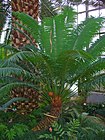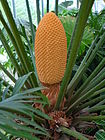Note: This is a project under development. The articles on this wiki are just being initiated and broadly incomplete. You can Help creating new pages.
Difference between revisions of "Cycas circinalis - Hintala"
| (11 intermediate revisions by the same user not shown) | |||
| Line 2: | Line 2: | ||
'''Hintala'''belongs to an ancient group of plants. It is a graceful palm like plant with though pinnate leaves and rough bark. Cycas circinalis is uncommon in India and can be found in dry as well as well as wet forests in peninsular India. | '''Hintala'''belongs to an ancient group of plants. It is a graceful palm like plant with though pinnate leaves and rough bark. Cycas circinalis is uncommon in India and can be found in dry as well as well as wet forests in peninsular India. | ||
==Uses== | ==Uses== | ||
| − | {{Uses|Arthritis}}, {{Uses|Burning sensation}}, {{Uses|Vomiting}}, {{Uses|Fever}}, {{Uses|Hemorrhoids}} | + | {{Uses|Arthritis}}, {{Uses|Burning sensation}}, {{Uses|Vomiting}}, {{Uses|Fever}}, {{Uses|Hemorrhoids}}.<ref name="Uses"/> |
| − | <ref name="Uses"/> | ||
==Parts Used== | ==Parts Used== | ||
| − | {{Parts Used|Bark}}, {{Parts Used|Leaves}}, {{Parts Used| | + | {{Parts Used|Bark}}, {{Parts Used|Leaves}}, {{Parts Used|Stem}}<ref name="Karnataka Medicinal Plants"/> |
| + | |||
==Chemical Composition== | ==Chemical Composition== | ||
| + | |||
==Common names== | ==Common names== | ||
| Line 31: | Line 32: | ||
==Habit== | ==Habit== | ||
| − | {{Habit|Palm | + | {{Habit|Palm like}} |
==Identification== | ==Identification== | ||
| Line 38: | Line 39: | ||
===Flower=== | ===Flower=== | ||
| − | {{Flower|Unisexual|Male and female on separate individuals|Yellow-brown|| Male Sago plants develop a cone approximately 30 cm tall coming from the center of the top.}} | + | {{Flower|Unisexual|Male and female on separate individuals|Yellow-brown|| Male Sago plants develop a cone approximately 30 cm tall coming from the center of the top. Flowering season is May to November}} |
===Fruit=== | ===Fruit=== | ||
| − | {{Fruit|||Globose|The seeds have a spongy layer that allows them to float on water. As a slow growing plant, the seed can take from 6–18 months to germinate|}} | + | {{Fruit|||Globose|The seeds have a spongy layer that allows them to float on water. As a slow growing plant, the seed can take from 6–18 months to germinate||Fruiting season is May to November}} |
===Other features=== | ===Other features=== | ||
| Line 71: | Line 72: | ||
File:Cycas circinalis female sporophyls with one seed plus unfertilized eggs in Prague.jpg | File:Cycas circinalis female sporophyls with one seed plus unfertilized eggs in Prague.jpg | ||
File:Cycas circinalis03.jpg | File:Cycas circinalis03.jpg | ||
| − | |||
</gallery> | </gallery> | ||
==References== | ==References== | ||
| − | |||
<references> | <references> | ||
| − | <ref name="Uses">http://dhaarrii.blogspot.com/2009/09/cycas-circinalis.html | + | <ref name="Uses">[http://dhaarrii.blogspot.com/2009/09/cycas-circinalis.html Uses]</ref> |
| − | + | <ref name="Leaf">[http://www.nbrienvis.nic.in/WriteReadData/CMS/Cycas%20circinalis.pdf Botanic description]</ref> | |
| − | <ref name="Leaf">[http://www.nbrienvis.nic.in/WriteReadData/CMS/Cycas%20circinalis.pdf | + | <ref name="Common names">[http://envis.frlht.org/bot_search Vernacular names]</ref> |
| − | <ref name="Common names">[http://envis.frlht.org/bot_search | + | <ref name="Karnataka Medicinal Plants">"Karnataka Medicinal Plants Volume - 2" by Dr.M. R. Gurudeva, Page No.594, Published by Divyachandra Prakashana, #45, Paapannana Tota, 1st Main road, Basaveshwara Nagara, Bengaluru. </ref> |
| − | |||
</references> | </references> | ||
==External Links== | ==External Links== | ||
| − | * http://tropical.theferns.info/viewtropical.php?id=Cycas+circinalis | + | * [http://tropical.theferns.info/viewtropical.php?id=Cycas+circinalis Cycas circinalis on the ferns.info] |
| − | * http://www.naturalmedicinalherbs.net/herbs/c/cycas-circinalis=sago-palm.php | + | * [http://www.naturalmedicinalherbs.net/herbs/c/cycas-circinalis=sago-palm.php Cycas circinalis on natural medicinal herbs.net] |
[[Category:Herbs]] | [[Category:Herbs]] | ||
[[Category:Plants of western ghats]] | [[Category:Plants of western ghats]] | ||
| − | |||
[[Category:Cycadaceae]] | [[Category:Cycadaceae]] | ||
Latest revision as of 17:04, 23 June 2023
Hintalabelongs to an ancient group of plants. It is a graceful palm like plant with though pinnate leaves and rough bark. Cycas circinalis is uncommon in India and can be found in dry as well as well as wet forests in peninsular India.
Contents
- 1 Uses
- 2 Parts Used
- 3 Chemical Composition
- 4 Common names
- 5 Properties
- 6 Habit
- 7 Identification
- 8 List of Ayurvedic medicine in which the herb is used
- 9 Where to get the saplings
- 10 Mode of Propagation
- 11 How to plant/cultivate
- 12 Commonly seen growing in areas
- 13 Photo Gallery
- 14 References
- 15 External Links
Uses
Arthritis, Burning sensation, Vomiting, Fever, Hemorrhoids.[1]
Parts Used
Chemical Composition
Common names
| Language | Common name |
|---|---|
| Kannada | Goddeechalu, Mundichalu |
| Hindi | Jangli madan |
| Malayalam | Eenthakay, Entha, Ichal, Indalapana, Toddapana |
| Tamil | Intapanai, Kama, Kama-maram, Madana-kamampu |
| Telugu | Dzavvubiyyamu, Kamakshi, Madana kamakshi, Madana mastu, Varugudu |
| Marathi | NA |
| Gujarathi | NA |
| Punjabi | NA |
| Kashmiri | NA |
| Sanskrit | Hintalah |
| English | Sago palm, Cycad |
Properties
Reference: Dravya - Substance, Rasa - Taste, Guna - Qualities, Veerya - Potency, Vipaka - Post-digesion effect, Karma - Pharmacological activity, Prabhava - Therepeutics.
Dravya
Rasa
Madhura (Sweet). Kashaya (Astringent)
Guna
Guru (Heavy), Snigdha (Oily)
Veerya
Sheeta (cold)
Vipaka
Karma
Pitta, Vata
Prabhava
Habit
Identification
Leaf
| Kind | Shape | Feature |
|---|---|---|
| Pinnate | Crowded at top of stem | The leaves are bright green, semiglossy, 150-250 cm long. |
Flower
| Type | Size | Color and composition | Stamen | More information |
|---|---|---|---|---|
| Unisexual | Male and female on separate individuals | Yellow-brown | Male Sago plants develop a cone approximately 30 cm tall coming from the center of the top. Flowering season is May to November |
Fruit
| Type | Size | Mass | Appearance | Seeds | More information |
|---|---|---|---|---|---|
| Globose | The seeds have a spongy layer that allows them to float on water. As a slow growing plant, the seed can take from 6–18 months to germinate | Fruiting season is May to November |
Other features
List of Ayurvedic medicine in which the herb is used
Where to get the saplings
Mode of Propagation
How to plant/cultivate
Season to grow
Soil type
Propagation
Commonly seen growing in areas
Photo Gallery
References
- ↑ Uses
- ↑ "Karnataka Medicinal Plants Volume - 2" by Dr.M. R. Gurudeva, Page No.594, Published by Divyachandra Prakashana, #45, Paapannana Tota, 1st Main road, Basaveshwara Nagara, Bengaluru.
- ↑ Vernacular names
- ↑ Botanic description
External Links
Categories:
- Ayurvedic Herbs known to be helpful to treat Arthritis
- Ayurvedic Herbs known to be helpful to treat Burning sensation
- Ayurvedic Herbs known to be helpful to treat Vomiting
- Ayurvedic Herbs known to be helpful to treat Fever
- Ayurvedic Herbs known to be helpful to treat Hemorrhoids
- Herbs with Bark used in medicine
- Herbs with Leaves used in medicine
- Herbs with Stem used in medicine
- Herbs with common name in Kannada
- Herbs with common name in Hindi
- Herbs with common name in Malayalam
- Herbs with common name in Tamil
- Herbs with common name in Telugu
- Herbs with common name in Sanskrit
- Herbs with common name in English
- Habit - Palm like
- Index of Plants which can be propagated by Seeds
- Herbs that are commonly seen in the region of Tropical area
- Herbs
- Plants of western ghats
- Cycadaceae




